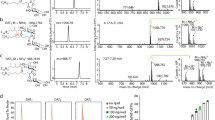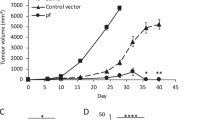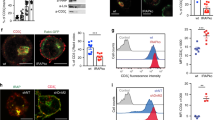Abstract
Simian virus 40 (SV40) large T antigen, a multifunctional protein necessary for lytic growth and cell transformation1, is located mainly in the nucleus2 and in small amounts on the cell surface (surface T)3–5. Surface T may have a passive role in SV40 tumour rejection by cytotoxic T cells as a component of SV40–TSTA (tumour-specific transplantation antigen)6. The unusual induction of this immune response by immunizing mice with soluble T antigen7 led us to investigate the in vitro binding of T antigen to the surface of living cells in more detail8,9. Our results show that native surface T and a minor subset of large T antigen having a high cell surface binding affinity in vitro, behave like integral membrane proteins9. Several viral proteins10–13 including SV40 T antigen14 and cellular proteins15 seem to be linked to fatty acids (acylation). To analyse whether this mechanism is involved in the stable attachment of in vitro-bound T antigen to the plasma membrane of living target cells, we determined the degree of labelling of this molecule by using target cells prelabelled with 3H-fatty acid. Here we report that T antigen extracted from unlabelled SV40-transformed cells (SV80) becomes 3H-labelled after in vitro binding to the cell surface of 3H-palmitate-prelabelled HeLa cells. These results suggest that T antigen attached externally to living cells, may be anchored by tightly linked lipids.
This is a preview of subscription content, access via your institution
Access options
Subscribe to this journal
Receive 51 print issues and online access
$199.00 per year
only $3.90 per issue
Buy this article
- Purchase on Springer Link
- Instant access to full article PDF
Prices may be subject to local taxes which are calculated during checkout
Similar content being viewed by others
References
Tooze, J. DNA Tumor Viruses (Cold Spring Harbor Laboratory, New York, 1981).
Pope, J. H. & Rowe, W. P. J. exp. Med. 120, 121–128 (1964).
Deppert, W. & Henning, R. Cold Spring Harb. Symp. quant. Biol. 44, 225–234 (1979).
Soule, H. R. & Butel, J. S. Virology 30, 523–532 (1979).
Henning, R., Lange-Mutschler, J. & Deppert, W. Virology 108, 325–337 (1981).
Tevethia, S. S. in Viral Oncology (ed. Klein, G.) 581–602 (Raven, New York, 1980).
Chang, Ch., Luborsky, S. W. & Mora, P. T. Nature 269, 438–440 (1977).
Lange-Mutschler, J. & Henning, R. Virology 117, 173–185 (1982).
Lange-Mutschler, J. & Henning, R. Virology 127, 333–344 (1983).
Schmidt, M. F. G., Bracha, M. & Schlesinger, M. J. Proc. natn. Acad. Sci. U.S.A. 76, 1687–1691 (1979).
Schmidt, M. F. G. & Schlesinger, M. J. Cell 17, 813–819 (1979).
Sefton, B. M., Trowbridge, I. S. & Cooper, J. A. Cell 31, 465–474 (1982).
Garber, E. A., Krueger, J. G., Hanafusa, H. & Goldberg, A. R. Nature 302, 161–163 (1983).
Klockmann, U. & Deppert, W. FEBS Lett. 151, 257–259 (1983).
Omary, M. B. & Trowbridge, I. S. J. biol. Chem. 256, 12888–12892 (1981).
Fiers, W. et al. Nature 273, 113–120 (1978).
Magee, A. I. & Schlesinger, M. J. Biochim. biophys. Acta 694, 279–289 (1982).
Harlow, E. L., Crawford, L. V., Pim, D. C. & Williamson, N. M. J. Virol. 39, 861–869 (1981).
Tegtmeyer, P. & Anderson, B. Virology 115, 67–74 (1981).
Kessler, S. W. J. Immun. 115, 1617–1624 (1975).
Laemmli, U. K. Nature 227, 680–685 (1970).
Author information
Authors and Affiliations
Rights and permissions
About this article
Cite this article
Henning, R., Lange-Mutschler, J. Tightly associated lipids may anchor SV40 large T antigen in plasma membrane. Nature 305, 736–738 (1983). https://doi.org/10.1038/305736a0
Received:
Accepted:
Issue Date:
DOI: https://doi.org/10.1038/305736a0
This article is cited by
-
Cupiennin 1a exhibits a remarkably broad, non-stereospecific cytolytic activity on bacteria, protozoan parasites, insects, and human cancer cells
Amino Acids (2011)
-
Recognition of influenza virus proteins by cytotoxic T lymphocytes
Immunologic Research (1987)
-
The role of cell membrane in the regulation of cell division and malignant transformation
Journal of Biosciences (1985)
Comments
By submitting a comment you agree to abide by our Terms and Community Guidelines. If you find something abusive or that does not comply with our terms or guidelines please flag it as inappropriate.



